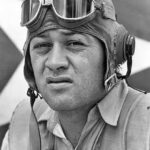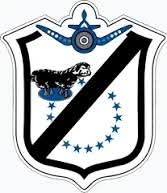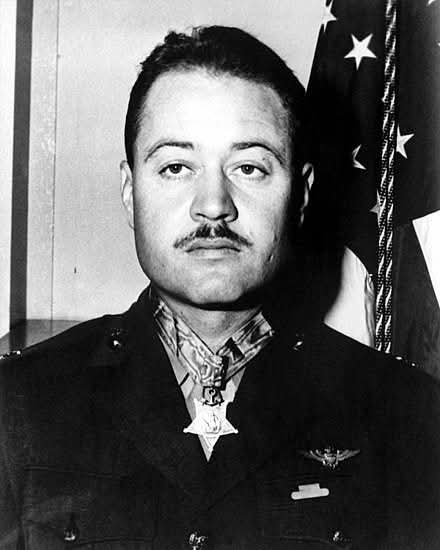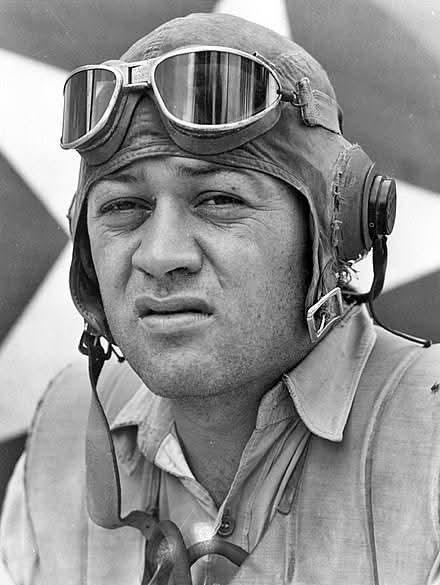
In college Boyington joined the ROTC and upon graduation was commissioned a second lieutenant in the United States Army.
When Boyington attempted to apply for flight training he was denied on the grounds that at that time the program excluded married men.
Boyington attempted to join the flight training program using his stepfather’s last name Hallenbeck. Upon receiving his birth certificate Gregory discovered that his real father had been Charles Boyington and Gregory enrolled in the flight training under the name Gregory Boyington.
1935 Boyington transferred to the US Marines reserve. 1937 Boyington qualified as a naval aviator. Boyington resigned from Marine reserves and received a commission as second lieutenant in the United States Marine Corps.



August 1941 Boyington resigned his commission and joined the American volunteers in China AKA The Flying Tigers.
Once the United States entered World War II Boyington returned to the United States Marine Corps and initially flew as a member of VMFA-122. From July to August 1944 Boyington who held the rank of Major commanded VMFA-112.
September 1944 Boyington was assigned to reorganize and command the previously disbanded VMF-214. At the time Boyington was 31 10 years older than many of the young pilots who were joining the rebuilt Squadron. Initially the pilots gave their commanding officer the nickname Gramps which was later changed to Pappy. The pilots of 214 initially requested that the Squadron be given the nickname Boyington’s Bastards. The name was rejected so the Squadron sent in a second request this time suggesting the name that the Squadron would become famous as the Black sheep(to reference the squadrons original selection for its name the squad emblem features a black bend sinister in which in coat of arms denotes bastardary).
On January 3rd 1944 Boyington was shot down and captured by the Japanese. He would spend the rest of the war a POW.
While serving as a pow he was declared KIA and awarded both the medal of Honor and Navy Cross.
October 1945 Boyington who had been liberated from the Japanese prison camp at the end of the war traveled to Washington DC.
On October 4th Boyington was presented the Naval Cross. The next day, October 5th, Boyington was among a number of Marines and United States Navy sailors who were awarded the medal of Honor by United States President Harry Truman at the White House.
Medal of Honor
CITATION:
For extraordinary heroism above and beyond the call of duty as Commanding Officer of Marine Fighting Squadron TWO FOURTEEN in action against enemy Japanese forces in Central Solomons Area from September 12, 1943, to January 3, 1944. Consistently outnumbered throughout successive hazardous flights over heavily defended hostile territory, Major Boyington struck at the enemy with daring and courageous persistence, leading his squadron into combat with devastating results to Japanese shipping, shore installations and aerial forces. Resolute in his efforts to inflict crippling damage on the enemy, Major BOYINGTON led a formation of twenty-four fighters over Kahili on October 17, and persistently circling the airdrome where sixty hostile aircraft were grounded, boldly challenged the Japanese to send up planes. Under his brilliant command, our fighters shot down twenty enemy craft in the ensuing action without the loss of a single ship. A superb airman and determined fighter against overwhelming odds, Major BOYINGTON personally destroyed 26 of the many Japanese planes shot down by his squadron and by his forceful leadership developed the combat readiness in his command which was a distinctive factor in the Allied aerial achievements in this vitally strategic area.
FRANKLIN D. ROOSEVELT
Navy Cross
Citation:
The President of the United States of America takes pleasure in presenting the Navy Cross to Major Gregory “Pappy” Boyington (MCSN: 0-5254), United States Marine Corps Reserve, for extraordinary heroism and distinguished service in the line of his profession as Commanding Officer and a Pilot of Marine Fighting Squadron TWO HUNDRED FOURTEEN (VMF-214), Marine Air Group ELEVEN (MAG-11), FIRST Marine Aircraft Wing, during action against enemy aerial forces in the New Britain Island Area on 3 January 1944. Climaxing a period of duty conspicuous for exceptional combat achievement, Major Boyington led a formation of Allied planes on a fighter sweep over Rabaul against a vastly superior number of hostile fighters. Diving in a steep run into the climbing Zeros, he made a daring attack, sending one Japanese fighter to destruction in flames. A tenacious and fearless airman under extremely hazardous conditions, Major Boyington succeeded in communicating to those who served with him, the brilliant and effective tactics developed through a careful study of enemy techniques, and led his men into combat with inspiring and courageous determination. His intrepid leadership and gallant fighting spirit reflect the highest credit upon the United States Naval Service.










Leave a Reply